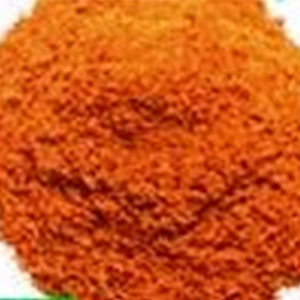
Ferric Ammonium Citrate contains not less than 16.5 percent and not more than 18.5 percent of iron (Fe).
Identification:
A: Ignite about 0.5 g: it chars, and leaves a residue of iron oxide.
B: To 10 mL of a solution of Ferric Ammonium Citrate (1 in 100) add 6 N ammonium hydroxide drop wise: the solution darkens, but no precipitate forms.
C: To 5 mL of a solution of Ferric Ammonium Citrate (1 in 100) add 0.3 mL of potassium permanganate TS and 4 mL of mercuric sulfate TS, and heat the mixture to boiling: a white precipitate forms.
Ferric citrate: To a solution of Ferric Ammonium Citrate (1 in 100) add potassium ferrocyanide TS: no blue precipitate is formed.
Sulfate: 0.3% Maximum.
Oxalate: Transfer 1 g to a 125-mL separator, dissolve in 10 mL of water, add 2 mL of hydrochloric acid, and extract successively with one 50-mL portion and one 20-mL portion of ether. Transfer the combined ether extracts to a 150-mL beaker, add 10 mL of water, and remove the ether by evaporation on a steam bath. Add 1 drop of glacial acetic acid and 1 mL of calcium acetate solution (1 in 20): no turbidity is produced within 5 minutes.
Mercury: not more than 10 µg per g is found..
Limit of lead: not more than 10 µg per g is found.
DESCRIPTION
Ferric Ammonium Citrate, Brown, occurs as thin, transparent brown, red-brown, or garnet red scales or granules, or as a brown-yellow powder. It is a complex salt of undetermined structure, composed of iron, ammonia, and citric acid. It is very soluble in water, but is insoluble in alcohol. The pH of a 1:20 aqueous solution is about 5.0 to 8.0. It is deliquescent in air and is affected by light.
Function: Nutrient.
REQUIREMENTS
Identification:
A. A 500-mg sample, when ignited, chars and leaves a residue of iron oxide.
B. Add 0.3 mL of potassium permanganate TS and 4 mL of mercuric sulfate TS to 5 mL of a 1:10 aqueous solution, and heat the mixture to boiling. A white precipitate forms.
C. Dissolve about 500 mg of sample in 5 mL of water, and add 5 mL of 1 N sodium hydroxide. A red-brown precipitate forms, and ammonia is evolved when the mixture is heated.
Assay: Not less than 16.5% and not more than 18.5% of iron (Fe).
Ferric Citrate: Passes test.
Lead: Not more than 2 mg/kg.
Mercury: Not more than 1 mg/kg.
Oxalate: Passes test.
Sulfate: Not more than 0.3%.